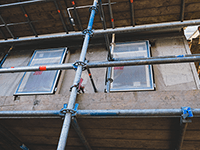
Most people are familiar with the typical process of buying a house using a residential mortgage. But what do you do when a traditional mortgage isn't an option due to the property condition?
In this situation, one option could be to use a bridging loan to buy the house. So, in this blog, we’ll look at some common situations where you may be able to use this option to help you buy a house.
When might I use a bridging loan for a property purchase?
There are several situations where this funding option may be useful for a property transaction.
Auction properties
Auctions are known for their fast-paced nature where time is of the essence. Winning bidders often need to pay a deposit on the auction day, which is typically around 10% of the property's value. The remaining balance must be settled within 28 days after the auction. If this deadline isn't met, there's a risk of losing the deposit.
In such situations, applying for a bridging loan can be useful. These loans are designed to be processed quickly, so they can give you the funds you need to complete within the required timescales.
Unmortgageable properties
Some properties may need large renovations to become habitable or meet mortgage lender criteria, such as those without working kitchens or bathrooms. These properties are often called "unmortgageable" due to their condition. This means it can be hard to get a traditional mortgage on the house.
In these circumstances, a bridging loan can help you buy this type of property. Lenders don't need the property to be habitable to approve the loan, as it's a short-term financing solution. Therefore, you can use the loan to buy the property and fund the renovations. Once the property is brought up to standard, you can then apply for a traditional mortgage or sell the property at a higher value and repay the loan.
Breaking a property chain
Another common use of these loans is to break property chains. In 2022, approximately one in three house sales in the UK had problems. If you've ever bought or sold a house before, you're likely familiar with the long and delicate nature of these processes. The more parties involved in buying your home, the higher the risk of the chain collapsing. Something as simple as a delay in paperwork processing could impact your chance of getting your dream home.
However, a bridging loan can turn you into a cash buyer. This allows you to buy your dream house and break the property chain. Once your previous home sells, you repay the loan. This is commonly known as chain break bridging.
What to consider before getting this solution
Whilst this option can be useful if you need to move quickly, it is typically more expensive than longer-term solutions. Therefore, you shouldn't enter into this type of agreement lightly. Make sure you carefully consider whether it is right for you and weigh up all the costs that may be involved.
Additionally, you also need to carefully consider your exit strategy, which is your plan to repay the loan. Without having a clearly defined plan, you will struggle to get accepted by lenders. This is also vital to protect the property you have used as security against the loan.
Summary
In summary, bridging loans can provide a flexible solution for buying houses in different situations. Whether it's fast-paced auctions, dealing with tricky properties, or breaking property chains, they can offer the speed and flexibility needed to close deals quickly. Therefore, it can be a useful option to explore if you’re in any of these situations.
Any property used as security, which may include your home, may be repossessed if you do not keep up repayments on your mortgage.




